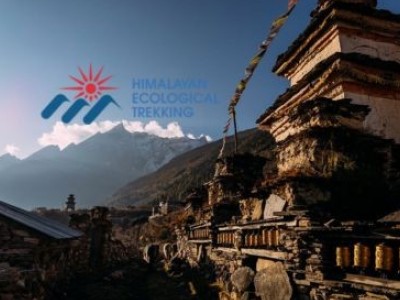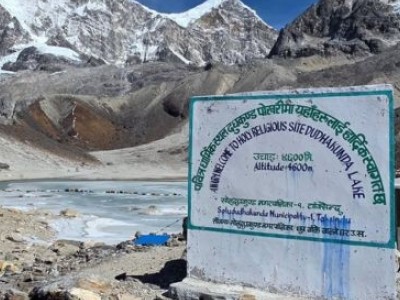Nepal's Eight-Thousander Peaks are the pinnacle of mountaineering success and nature's greatest monuments to adventure. A landlocked country in the heart of the Himalayas, Nepal contains eight of the fourteen mountains in the world that rise to over 8,000 m. These giant peaks, including the legendary Everest, have fascinated explorers, climbers, and adventurers for many years. From the snow-capped peak of Annapurna to the daunting ridges of Kanchenjunga, Nepal's 8,000 m peaks offer an unparalleled sense of adventure through trekking and high-altitude mountaineering. Whether you're planning an expedition to summit these iconic giants or simply trek through the awe-inspiring landscapes that surround them, you need to know these highest mountains in Nepal.
Table of Contents
Nepal – Home of the Mighty eight thousanders
Located along the famous Himalayan range, Nepal is fortunate to have a unique concentration of extremely tall mountains. The Himalayan peaks of Nepal, over 8000m, create a beautiful crown that represents the northern edge of Nepal next to Tibet. Such a concentration of extreme altitude provides Nepal with no rivals as the recreational capital of high-altitude mountaineering, attracting thousands of climbers and trekkers to visit every year.
In preparation for your adventure, using a reputable operator such as Himalayan Ecological Trekking will ensure a safe, responsible, and amazing experience in these jaw-dropping places.
What Are Eight-Thousanders?
Eight-thousanders are the fourteen peaks on earth that are higher than 8000 meters (26,247 feet) above sea level. These peaks are the highest standard in mountaineering that climbers can face, where they encounter extreme altitude, life-threatening weather, low oxygen, and other technical challenges to discover the limits of human endurance.
All fourteen peaks are located in the Himalaya and Karakoram ranges, and out of the eight-thousanders in the world, eight, meaning that they are the epicentre for serious mountaineering. The most important factor of the rising 8000m peaks is known as the 'death zone', which is the altitude greater than 8000 meters, where the human body cannot acclimatise.
List of Eight-Thousanders in Nepal (All 8 Peaks)
Nepal proudly hosts eight of the world's fourteen eight-thousanders:
- Mount Everest (8,848.86m) – The world's highest peak, known locally as Sagarmatha
- Kanchenjunga (8,586m) – The third-highest mountain, straddling the Nepal-Sikkim border
- Lhotse (8,516m) – The fourth-highest peak, connected to Everest via the South Col
- Makalu (8,485m) – The fifth-highest mountain, featuring a distinctive pyramid shape
- Cho Oyu (8,188m) – The sixth-highest peak, often regarded as the "easiest" eight-thousander
- Dhaulagiri I (8,167m) – The seventh-highest mountain, meaning "White Mountain"
- Manaslu (8,163m) – The eighth-highest peak, called "Mountain of the Spirit"
- Annapurna I (8,091m) – The tenth-highest mountain with the highest fatality rate
Climbing Difficulty Levels of 8000m Peaks
Grasping relative difficulty prepares climbers:
Moderate: Cho Oyu – Often called the "easiest" eight-thousander with non-technical sections.
High: Manaslu, Dhaulagiri I, Mount Everest – Significant avalanche risk, steepness, and height.
Very High: Lhotse, Makalu, Kanchenjunga – Technical climbing, remote, and a risk of unpredictable weather patterns.
Extreme: Annapurna I – Most dangerous eight-thousander (e.g., 32% fatality rate), due to numerous avalanches with technical routes.
Permit Costs and Required Documents
Nepal mountaineering expeditions require official permits:
Mount Everest:
- Spring: USD $11,000 per person
- Autumn: USD $5,500 per person
Other Eight-Thousanders:
- Spring: USD $1,800 per person
- Autumn: USD $900 per person
Required Documents:
- Valid passport (6+ months validity)
- Climbing CV with previous experience
- Medical fitness certificate
- Travel insurance covering helicopter evacuation
- Liaison officer fees
- Environmental deposit (refundable)
With the help of Himalayan Ecological Trekking, you can avoid the daunting and complicated process of acquiring the required permissions and making sure everything is accomplished properly.
Best Season to Climb Eight-Thousanders in Nepal
Spring Season (April-May): Spring is the most favoured season due to the stable weather, comparatively warm temperatures, and longer summit days available. Spring is the best time to climb 8000m peaks.
Autumn Season (September-November): Autumn will provide good weather with crisp, cool temperatures and national mountain visibility. Autumn is less crowded than Spring and boasts stable weather.
Winter/Summer Season: Winter is a challenge with severe cold, strong winds, and summer is challenging due to heavy monsoon rains. Permit costs for these seasons are significantly lower across the board due to the extreme difficulty of climbing these mountains.
For trekking and base camps, both Spring and Autumn are excellent conditions for the Everest Base Camp Trek, the Annapurna Circuit Trek, and the Manaslu Circuit Trek.
Trekking Routes to Access the Base Camps
Climbing the 8000m peaks of Nepal requires significant experience and preparation, but simply trekking to the base camps is an adventurous way to enjoy stunning views and culture. Below is a summary of the major trekking routes:
Everest Base Camp Trek (EBC): The most popular trek in the world begins with a dramatic flight to Lukla and weaves through famous Sherpa villages such as Namche Bazaar, Tengboche (famous for its monastery), Dingboche, and Lobuche to arrive at Everest Base Camp at 5,364 meters. The trek takes approximately 12-14 days, and can be linked with ascents of Kala Patthar (5,545m) for stunning views of Everest. The route also has access to Lhotse and connects to Cho Oyu approaches as well.
Annapurna Base Camp Trek (ABC): The trek begins in either Pokhara or Nayapul, and leads to terraced farmlands, rhododendron forests, and traditional Gurung villages, before entering the Annapurna Sanctuary, a natural amphitheater surrounded by enormous peaks. The basecamp is situated at 4,130 meters and provides 360-degree views of Annapurna I, Annapurna South, Hiunchuli, and Machhapuchhre (Fishtail). Duration: 7-12 days, depending on the speed of travel and acclimatization process.
Annapurna Circuit Trek: A classic trek in the world, the Annapurna Circuit circumnavigates the entire Annapurna massif and crosses the Thorong La (5,416m) pass. This trek offers both mountain scenery and cultural diversity, as the trek transitions from Hindu villages in the lowlands to Buddhist villages in the higher elevations. Duration: 15-20 days.
Manaslu Circuit Trek: This trek is becoming a popular alternative to the bustling Annapurna Circuit, which circumnavigates Manaslu through remote villages and crosses the Larkya La(5,160m) pass. This route is less crowded than the Annapurna Circuit but allows trekkers to experience both genuine culture and great mountain views. Duration: 14-18 days.
Makalu Base Camp Trek: An isolated and challenging trek in Makalu Barun National Park, featuring extraordinary biodiversity and wilderness. The route passes through the ethnic Sherpa and Rai settlements and ends at Makalu Base Camp, which sits at 4,870 meters. Duration: 18-22 days.
Kanchenjunga Base Camp Trek: The longest and most isolated mainstream trek in Nepal features two base camp options (North and South). The trek travels through far eastern Nepal, has exceptional ecosystems, traditional cultures, and is far removed from crowds of trekkers. Duration: 20-25 days.
Dhaulagiri Circuit Trek: Trekking around Dhaulagiri, through isolated valleys, and crossing the French Pass (5,360m) and Dhampus Pass (5,200m), is one of the toughest treks in Nepal. This is an expedition-style trek that involves camping and requires logistical support. The trek takes about 18-21 days.
Himalayan Ecological Trekking specializes in organizing these amazing Nepal trekking and climbing peaks trips, providing experienced guides, proper logistics, and responsible tourism practices that give back to the local communities.
Required Skills & Physical Preparation
Physical Preparation
- Months of cardiovascular training (running, cycling, hiking)
- Strength training focusing on core and legs
- Previous experience at 6,000-7,000m essential
- Training with weighted packs on steep terrain
Technical Skills
- Ice climbing proficiency
- Rock climbing ability
- Rope work and fixed-line techniques
- Glacier travel and crevasse navigation
Mental Preparation
- Decision-making under pressure
- Risk assessment
- Team dynamics
- Knowing when to turn back
Safety Tips & Altitude Sickness
Prevention
- Gradual ascent (300-500m per day above 3,000m)
- Drink 4-5 liters daily
- Recognize symptoms: headache, nausea, dizziness
- Immediate descent if symptoms worsen
Emergency Services
- Helicopter evacuation available up to 7,000m
- Comprehensive insurance is mandatory
- Costs: USD $10,000-50,000 depending on altitude
Himalayan Ecological Trekking ensures safety with an experienced Sherpa team, multiple emergency procedures, and proper communication equipment on the expedition.
Why Choose Nepal for High-Altitude Expeditions
Geographic Advantages: Eight 8000m peaks in one country, with easy-to-access southern approaches, and good infrastructure.
Cultural Advantages: Home to the legendary Sherpa people, the stunning non-denominational Buddhist monasteries, and a warm sense of hospitality that creates lasting memories.
Logistical advantages: Well-established permit systems, great support for expeditions, and operators with decades of experience.
Cost effectiveness: Good pricing and a strong local expedition industry to help keep expeditions affordable.
Additional attractions: Beyond the mountains are Pokhara's lakeside location, Chitwan National Park's wildlife, and the UNESCO Heritage Sites of the Kathmandu Valley.
FAQs
What are the eight-thousanders in Nepal?
Nepal has eight of the fourteen 8000m+ peaks in the world. They include Everest, Kanchenjunga, Lhotse, Makalu, Cho Oyu, Dhaulagiri, Manaslu, and Annapurna.
Which 8000m peak is the easiest to climb?
The easiest 8000m peak to climb is Cho Oyu, although all eight-thousanders are extremely challenging and require experience.
What is the best climbing season?
Spring (April-May) is typically the best. The fall (September-November) is the second-best season.
How much does climbing cost?
Climbing costs vary from about $30,000-$50,000 for most peaks to $40,000-$100,000+ for Everest.
Can I trek to base camps if I am a beginner?
Absolutely! Base camp treks like Everest Base Camp and Annapurna Base Camp require no technical skills, only good fitness.
Eight-Thousanders in Nepal - A Mountaineer's Paradise
The Eight-Thousander Peaks in Nepal are, without a doubt, the world's ultimate frontier for adventurous people. These 8 massive giants call on climbers to see how far you can push your limits as you face the most extreme conditions on the planet.
If you dream of standing on top of the world's highest peak, or if you prefer to trek, Nepal offers world-class opportunities to explore. In addition to the Everest Base Camp Trek, Nepal offers the Kanchenjunga Base Camp Trek, the Annapurna Circuit Trek, and the Manaslu Circuit Trek, all opportunities for all levels of adventure trekking.
Himalayan Ecological Trekking is here to help bring your dreams to fruition! Our staff will provide you with our mountaineering expertise, logistics, commitment to your safety, and sustainable tourism, which benefits local communities.
The 8000m peaks of Nepal are waiting for you. Contact Himalayan Ecological Trekking today, and we can begin to plan your life-changing adventure in the majestic eight-thousanders of the Himalaya. Ready to Experience the Eight-Thousanders?
Contact Himalayan Ecological Trekking today to start planning your adventure to the Eight-Thousander Peaks in Nepal. Your Himalayan adventure awaits!


